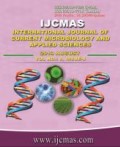


 National Academy of Agricultural Sciences (NAAS)
National Academy of Agricultural Sciences (NAAS)

|
PRINT ISSN : 2319-7692
Online ISSN : 2319-7706 Issues : 12 per year Publisher : Excellent Publishers Email : editorijcmas@gmail.com / submit@ijcmas.com Editor-in-chief: Dr.M.Prakash Index Copernicus ICV 2018: 95.39 NAAS RATING 2020: 5.38 |
Sorghum is an essential crop in the semi-arid tropics being attacked by nearly 150 species of insects, out of which Chilo partellus is the more devastating pest. Based on the foliar damage the resistance and susceptible genotypes of sorghum can be screened. For further understanding of the host plant resistance relationship between sorghum and stem borer the orientation behaviour and larval establishment behaviour can be studied. The host plant resistance in sorghum to C. partellus can be either morphological or biochemical. Plant morphological characters such as hairs on upper leaf surface, trichome length and density have been reported to affect the orientation, settling and feeding behaviour of insects. Among the biochemical factors under consideration, some are constitutive and some may be induced in response to attack by insects. Morphological, allelochemical and biochemical character decide the host plant preference of the insect. Moreover, the expression of resistance to a particular insect is not governed by a single biochemical factor rather the interaction of diverse biochemical constituents lead to differential levels of host plant resistance to a single or a diverse array of insects. Among the biochemical factors, proteins, total lipids, total sugars, total tannins, total flavonoids, different amino acids and lipophilic compounds play a significant deciding role in determining in resistance\susceptibility. Furthermore, various enzymes such as catalase, peroxidase, superoxide dismutase etc. also impart significant resistance or susceptibility to diverse array of insects. The study of biochemical factors influencing resistance or susceptibility may be further open up new ways for developing new biochemical markers which could be further helpful in developing resistant varieties. Moreover, the elite genotypes can be screened to devise a resistant variety by eliminating the susceptibility related genes.
 |
 |
 |
 |
 |